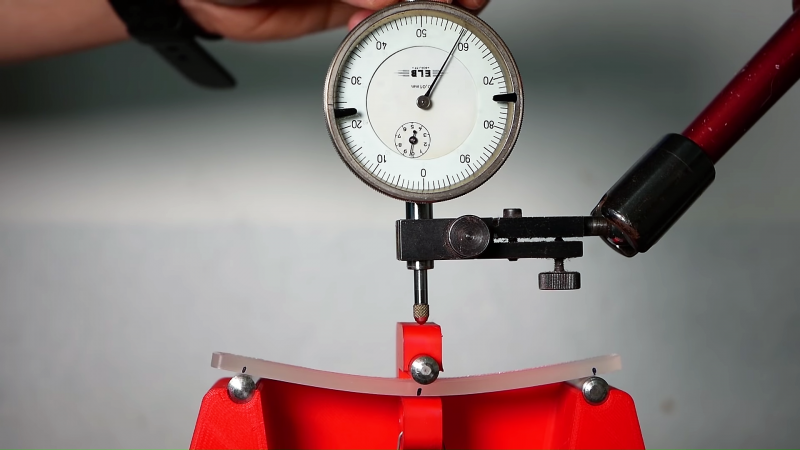How do you choose filament when you want strong 3D-printed parts? Like most of us, you probably take a guess, or just use what you have on hand and hope for the best. But armed with a little knowledge on strength of materials, you might be able to make a more educated assessment.
To help you further your armchair mechanical engineer ambitions, [Stefan] has thoughtfully put together this video of tests he conducted to determine the stiffness of common 3D-printing plastics. He’s quick to point out that strength and stiffness are not the same thing, and that stiffness might be more important than strength in some applications. Strength measures how much stress can be applied to an element before it deforms, while stiffness describes how well an element returns to its original state after being stressed. The test rig [Stefan] built for the video analyzes stiffness by measuring the deflection of printed parts under increasing loads. Graphing the applied force versus the deflection gives an indication of the rigidity of the part, while taking the thickness of the material into account yields the bending modulus. The results are not terribly surprising, with polypropylene being the floppiest material and exotic composite filaments, like glass fiber or even “nanodiamond” reinforced PLA coming out as the stiffest. PLA, the workhorse filament, comes in around the middle of the pack.
[Stefan] did some great work here, but as he points out, in the final analysis it almost doesn’t matter what the stiffness and strength of the filament are since you can easily change your design and add more material where it’s needed. That only works up to a point, of course, but it’s one of the many advantages of additive manufacturing.















The stiffness of plastics is a rather moot point, because plastics also have high creep. You leave them under any significant tension and they sag.
https://thrinter.com/creep-abs-pla-petg-alloy-910/
There are plenty of applications for plastics that don’t involve them being constantly loaded. i.e. most of them.
Naturally. Simply notice that in applications where plastics would be put under constant tension, they fail, so plastics aren’t applied there.
Nor is some metals/alloys. But isn’t it basic engineering to choose the right material?
I’ve been telling people that PLA was stiffer (and better for printing the parts that go into a 3d printer rather then PETG) for a long time. Thanks for doing this test.
Yes PLA is more rigid, but also has a lower glass transition temperature. Let’s also be realistic about the loads involved in a 3D printer, is not like a CNC mill with a multiple horsepower spindle but more along the lines of a laser cutter… very low.
In an open 3D printer where you’re dealing with low warp materials, PLA is probably a reasonable choice. Things change when your printing ABS, nylon, or polycarbonate and have to run an enclosure…suddenly those PLA parts start to deform when a PETG part would be fine.
In neither case is the initial rigidly a real concern becuase the loads are so low. It’s all about selecting the right material for your application.
If you anneal the PLA it will handle higher temperatures than ABS or PETG.
Yes but it will also deform shrink and warp
Grows ~2% in Z and shrinks ~2% in X and Y, which is easy to compensate for by scaling the model in the slicer. (I have seen other numbers, maybe dependent on the filament or the layer height?) Not seen significant deformation or warping. I should add that I have only annealed relatively sturdy parts (atleast 2mm feature size, >=90% infill), perhaps that has kept the parts from deforming when softened.
I’d much rather use a bit more petg filament to compensate than end up with a melty sagging 3d printer. Who cares if it’s technically stiffer per gram? It turns to peanut butter on a sunny day.
Completely agree about PLA. it’s great for tugboats and other throw-aways, but useless material for anything that matters. PLA filament absorbs moisture from the air and becomes brittle. So do the prints.
I work in ready mix. This is like a mortar bar test. I would like to see compression tests and torsion test. That would really give you an idea of the strengths and weaknesses of different plastics.
I think that you may have mixed up the definitions of stiffness and strength:
Stiffness is an extensive material property that is defined by the resistance of an elastic body to deflection or deformation by an applied force. (Source: ScienceDirect)
Yeah, stiffness is a measure of the strain/stress relationship: it measures how much deflection you get per unit of applied force. The stiffness per unit weight (or volume or whatever) of a material is an intrinsic property of the material, and that’s what he’s measuring.
The intro paragraph implies that he’s measuring elasticity: amount of deflection a material can take and still return to its original shape when the applied force is removed.
If you make a graph, with deflection/strain on one axis, applied force/stress on the other, you’ll get a line that starts at 0,0 and rises linearly to some point, at which it starts curving, and eventually stops. The stopping point is the point at which the material has failed entirely. The linear rise is stiffness, or elastic deformation, and the point at which it’s started curving, where it’s deforming permanently, represents its tensile strength.
Stiffness or strength is certainly interesting to know before you use it to make something important. But what about durability? How does the part degrade when left in the sun, a hot car, a moist environment, repetitive strain. Let’s ignore the effects of certain cleaning chemicals or the abrasive effects of sand and salt.
But regarding the project, you’ve got to start somewhere and this project does did that. Interesting.
The nanodiamond material also has a higher temperature performance than normal PLA. I’ve been using it on some car parts with good effect. https://carbodeon.com/high-temperature-3d-printed-parts-with-udiamond-pla/